- Clone
- A17013D (See other available formats)
- Regulatory Status
- RUO
- Other Names
- Proto-oncogene tyrosine kinase lck, p56-Lck, T-cell specific protein tyrosine kinase
- Isotype
- Mouse IgG1, κ
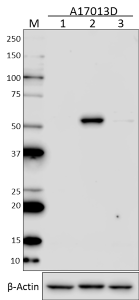
-

Total cell lysates (15 μg protein) prepared from HeLa (negative control, Lane 1), Jurkat (Lane 2), or EL4 (Lane 3) cells were resolved by 4-20% Tris-Glycine gel electrophoresis, transferred to nitrocellulose, and probed with 1 μg/mL (1:500 dilution) purified anti-Lck (clone A17013D). Proteins were visualized by chemiluminescence detection using HRP goat anti-mouse-IgG (Cat. No. 405301) at a 1:3000 dilution. Equal loading was confirmed using Direct-Blot™ HRP anti-Actin antibody (Cat. No. 643807) at a 1:5000 dilution. Lane M: MW marker. -

Total cell lysates (15 μg protein) prepared from Jurkat cells were resolved by 4-20% Tris-Glycine gel electrophoresis, transferred to nitrocellulose, and probed with the indicated concentration of purified anti-LCK (clones A17013D and LCK-01). Proteins were visualized by chemiluminescence detection using HRP goat anti-mouse-IgG (Cat. No. 405301) at a 1:3000 dilution. Lane M: MW marker. -

Total cell lysates (15 μg protein) prepared from serum starved Jurkat cells treated without (Lane 1) or with (Lane 2) 2 mM H2O2 for 3 minutes were resolved by 4-20% Tris-Glycine gel electrophoresis, transferred to nitrocellulose, and probed with purified anti-Lck Phospho (Tyr505) at 1.0 μg/mL (Cat. No. 684301), purified anti-LCK (clone LCK-01) at 1.0 μg/mL, or purified anti-Lck (Cat. No. 628301) at 1.0 μg/mL. Proteins were visualized by chemiluminescence detection using HRP goat anti-mouse-IgG (Cat. No. 405301) at a 1:3000 dilution. Lane M: MW marker. -

Jurkat cells were fixed with 4% paraformaldehyde for 10 minutes, permeabilized with 0.5% Triton X-100 for 10 minutes, and blocked with 10% FBS for 60 minutes. Cells were then intracellularly stained with an isotype control antibody at 2.0 μg/mL (1:250 dilution, Panel A), purified anti-Lck clone A17013D at 2.0 µg/mL (1:250 dilution, Panel B) and 1.0 μg/mL (1:500 dilution, Panel C), or purified anti-Lck clone LCK-01 at 2.0 µg/mL (1:250 dilution, Panel D) and 1.0 µg/mL (1:500 dilution, Panel E). Following incubation of all antibodies for two hours at room temperature, cells were incubated with Alexa Fluor® 594 goat anti-mouse IgG (Cat. No. 405308) at 2.0 µg/mL. Nuclei were counterstained with DAPI and the image was captured with a 60X objective. -

Whole cell extracts (250 µg total protein) prepared from Jurkat cells were immunoprecipitated overnight with 2.5 µg of Purified mouse IgG1, κ Isotype Control Antibody (Cat. No. 401401) or Purified anti-Lck Antibody, clone A17013D. The resulting IP fractions and whole cell extract input (6%) were resolved by 4-12% Bis-Tris gel electrophoresis, transferred to a PVDF membrane, and probed with a 1.0 µg/mL (1:500 dilution) of A17013D. Lane M: Molecular Weight marker.
| Cat # | Size | Price | Quantity Check Availability | ||
|---|---|---|---|---|---|
| 601001 | 25 µg | $101.00 | |||
| 601002 | 100 µg | $253.00 | |||
Lck is a 56 kD tyrosine protein kinase and a member of the src subfamily that contains both an SH2 and SH3 domain. Alternatively spliced isoforms of Lck have been reported. Lck is a cytoplasmic protein bound to CD4 and CD8 in T lymphocytes that participates in antigen-induced T cell activation through phosphorylation of the T cell receptor zeta chain. Lck is activated upon T cell receptor engagement and is involved in the onset of cell cycle progression induced by interleukin-2. Phosphorylation by Csk downregulates the activity of Lck. In addition to CD4 and CD8, Lck has been reported to interact with PI3K through its SH3 domain and tyrosine phosphorylated KHDRBS1/p70 through its SH2 domain. In addition, Lck has been shown to associate with the SAP transmembrane tyrosine phosphatase.
Product Details
- Verified Reactivity
- Human, Mouse
- Antibody Type
- Monoclonal
- Host Species
- Mouse
- Immunogen
- Human Lck peptide phosphorylated around Tyr505.
- Formulation
- Phosphate-buffered solution, pH 7.2, containing 0.09% sodium azide.
- Preparation
- The antibody was purified by affinity chromatography.
- Concentration
- 0.5 mg/ml
- Storage & Handling
- The antibody solution should be stored undiluted between 2°C and 8°C.
- Application
-
WB - Quality tested
ICC, IP - Verified - Recommended Usage
-
Each lot of this antibody is quality control tested by Western blotting. For Western blotting, the suggested use of this reagent is 0.25 - 2.0 ug/mL (1:250-2000 dilution) µg per ml. For immunocytochemistry, a concentration range of 1.0 - 2.0 μg/ml (1:100-1:250 dilution) is recommended. For immunoprecipitation, the suggested use of this reagent is 2.5 µg per ml. It is recommended that the reagent be titrated for optimal performance for each application.
- Application Notes
-
Clone A17013D was derived from a human Lck peptide phosphorylated at Y505 immunogen, but still displayed pan reactivity towards the unmodified peptide during western blot screening. This clone was moderately stronger than BioLegend clone LCK-01 for western blot and substantially stronger for immunofluorescence microscopy in parallel testing. But it shows a weak affinity towards mouse Lck. This clone is predicted to recognize both 58 and 61 kD isoforms based off the presence of the immunizing epitope in both proteins and may also recognize certain SRC tyrosine kinase family members due to high sequence similarity.
Phosphorylation of Lck Y505 reduces binding of this antibody by western blot (please see Fig. 3); we recommend LCK-01 as a pan control antibody.
The additional band of ~ 50 kD detected bellow the canonical Lck band in IP experiment could be Lck degradation product. - RRID
-
AB_2728456 (BioLegend Cat. No. 601001)
AB_2728456 (BioLegend Cat. No. 601002)
Antigen Details
- Distribution
-
Cytoplasmic protein, bound to cytoplasmic CD4 and CD8 in T lymphocytes.
- Function
- Participates in antigen-induced T cell activation, phosphorylates zeta chain of T cell receptor. Involved in interleukin-2 induced onset of cell cycle progression.
- Interaction
- Associates with CD4 and CD8 co-receptors. Binds to PI3K through SH3 interactions, binds to tyrosine phosphorylated KHDRBS1/p70 through SH2 domain. Interacts with SAP transmembrane tyrosine phosphatase.
- Biology Area
- Cell Biology, Signal Transduction, Transcription Factors
- Antigen References
-
- Koga Y, et al. 1986. Eur. J. Immunol. 16:1643.
- Vogel LB, et al. 1995. Biochem. Biophys. Acta 1264:168.
- Vogel LB and Fujita DJ. 1993. Mol. Cell. Biol. 13:7408.
- Bergman M, et al. 1992. EMBO J. 11:2919.
- Gene ID
- 3932 View all products for this Gene ID
- UniProt
- View information about Lck on UniProt.org
Other Formats
View All Lck Reagents Request Custom Conjugation| Description | Clone | Applications |
|---|---|---|
| Purified anti-Lck | A17013D | WB,ICC,IP |
Compare Data Across All Formats
This data display is provided for general comparisons between formats.
Your actual data may vary due to variations in samples, target cells, instruments and their settings, staining conditions, and other factors.
If you need assistance with selecting the best format contact our expert technical support team.
-
Purified anti-Lck
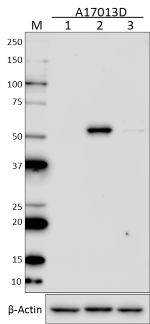
Total cell lysates (15 μg protein) prepared from HeLa (negat... 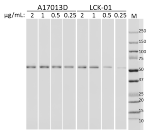
Total cell lysates (15 μg protein) prepared from Jurkat cell... 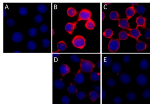
Jurkat cells were fixed with 4% paraformaldehyde for 10 minu... 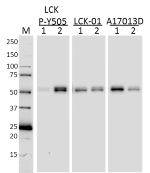
Total cell lysates (15 μg protein) prepared from serum starv... 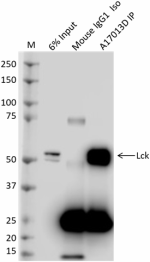
Whole cell extracts (250 µg total protein) prepared from Jur...
